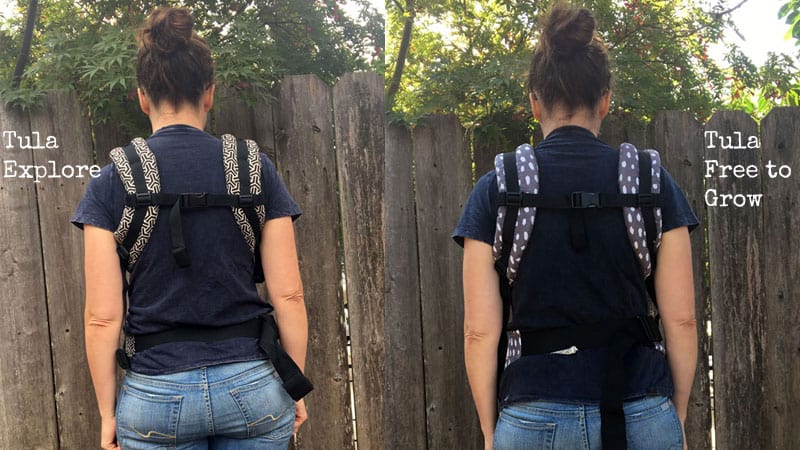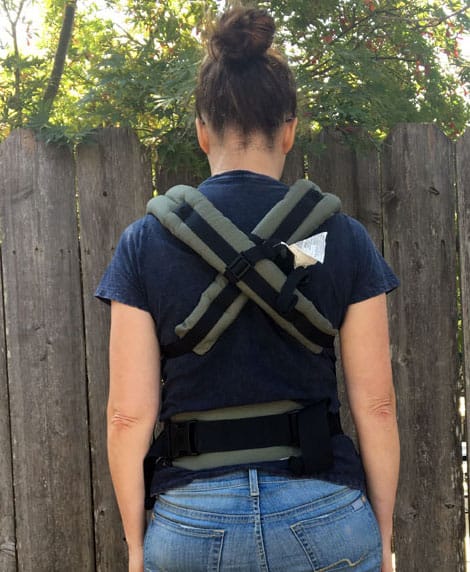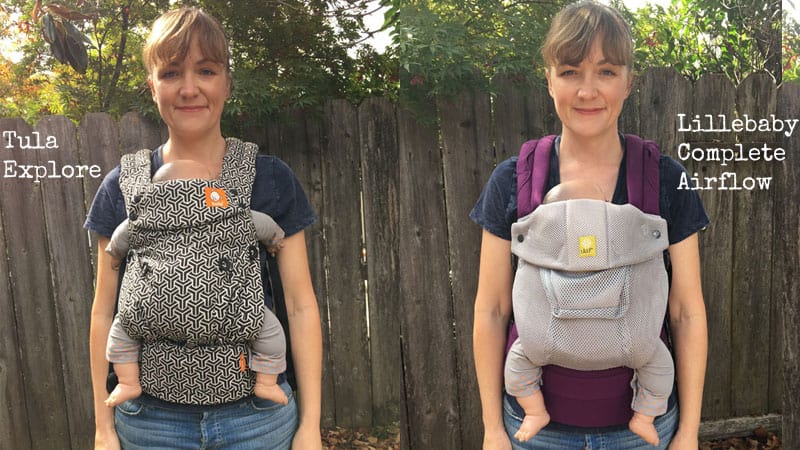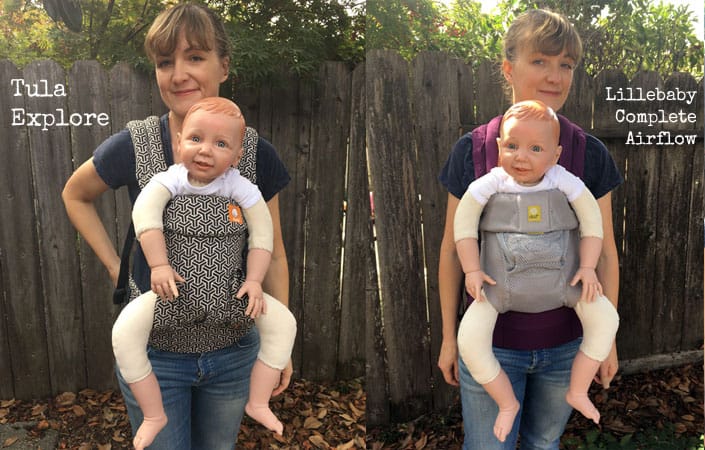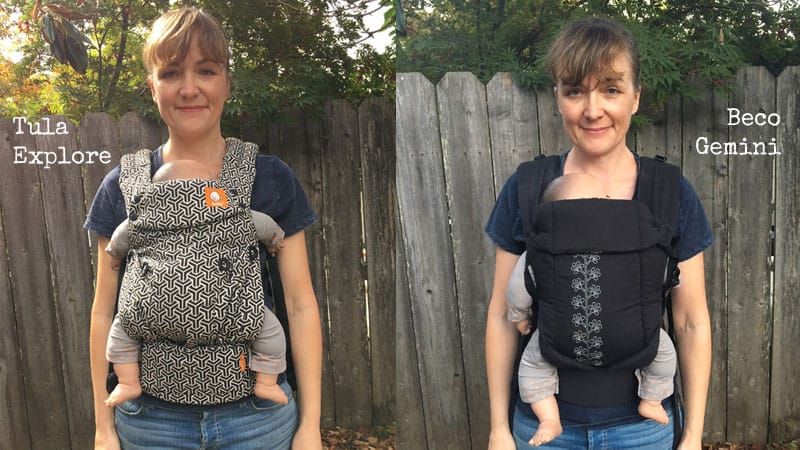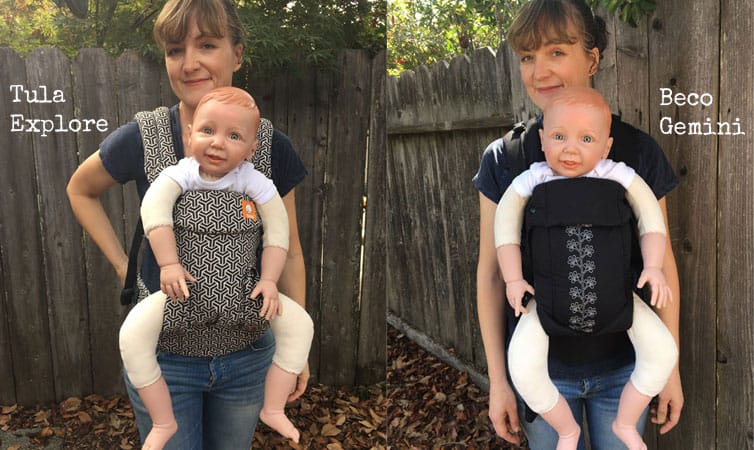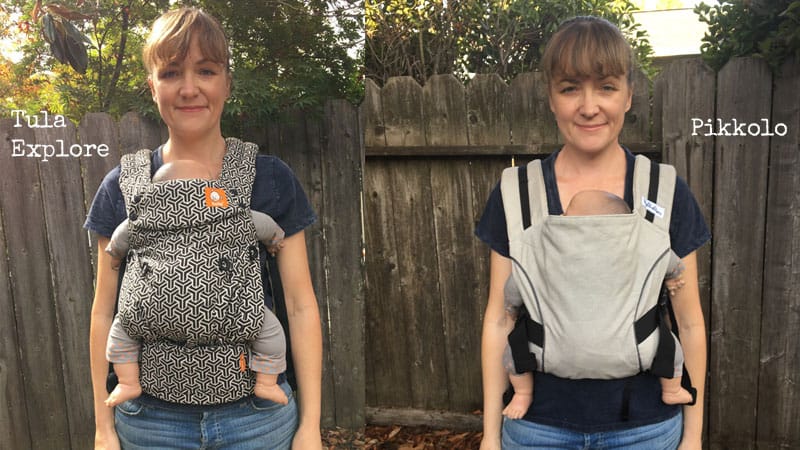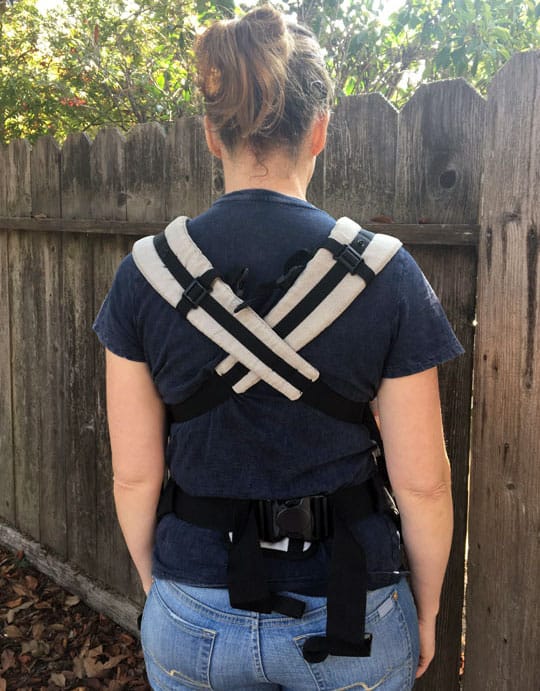
This article offers tons of comparison details of the Tula Explore vs. other infant carriers!
For more on how to choose a baby carrier and various compare charts of different baby carriers,click on the link to see all the articles we’ve written for you: https://carrymeaway.com/learn-center/
The new Tula Explore carrier made its debut this week. It’s been getting rave reviews, especially from Tula fans who loved the Tula comfort but wish the carriers had a forward-facing option. The Explore offers the option for face baby forward (as well as front facing in and back carries), and in an ergonomic position for baby. Woohoo!
The Tula Explore is not, of course, the first forward-facing carrier on the market. So I thought y’all might be interested in reading about how the Explore compares to some of the other popular forward-facing carriers out and also to the Tula Free to Grow. If so, this blog post is for you.
For reference, I am 5’4″ and weigh 145lbs. I wear a size Medium in most shirts.
Tula Explore vs. Tula Free to Grow
The Tula Free to Grow is one of my favorite infant carriers- I love it for its good looks, adjustability, and the light cotton body that is pretty flexible and soft. So I was curious to see how the Tula Explore is similar and different.
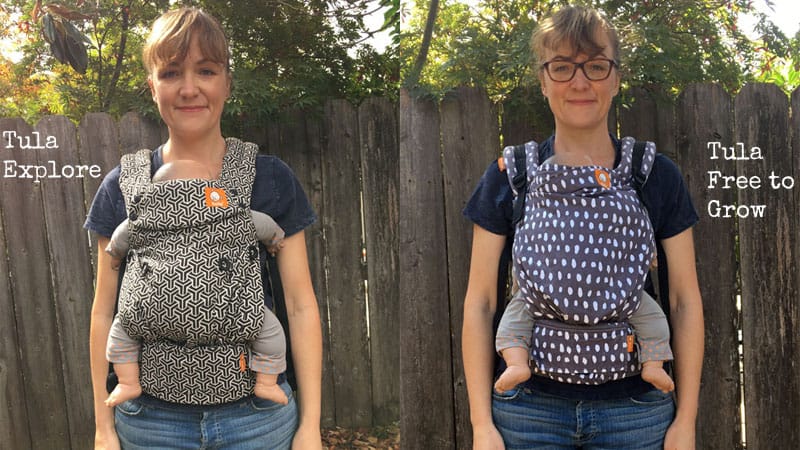 Similarities between the Tula Explore and Tula FTG
Similarities between the Tula Explore and Tula FTG
These two carriers feel much the same on my body. The shoulder straps are a similar width and thickness and they distribute the weight similarly. They use the same adjustment mechanism at the base of the carrier to make the base narrow for little ones and wider for older babies and toddlers
Both carriers offer front and back carrying positions. Both carriers have the Tula pocket on the waistband. Both carriers fasten similarly on the back and feel the same. From the back, I’m not sure I can even tell the difference between these carriers, except for the print!
Both Explore Carrier and the Free-to-Grow Carrier can be used for a newborn ( starting at 7 pounds), since they don’t require any infant inserts。
Main differences between the Tula Explore and Tula FTG
The main difference between these two carriers is the Tula Explore offers the forward-facing position, while the Tula Free-to-Grow (aka Tula FTG) does not. This leads to a lot of changes in the body of the carrier.
The Tula Free to Grow is two layers of thin, soft cotton. This keeps it lightweight and very moldable to the baby’s body. The Explore is much more structured on the body, to be able to provide the forward-facing position. It is the same soft cotton of the FTG, but the Explore has some lightweight padding all around the body of the carrier. It also has additional buttons and flaps that adjust to allow for the different carrying options.
The Free to Grow has extender buckles at the top of the carrier which allows you to shorten or lengthen the body. The Explore has a headrest that flips up or down, depending on how big the baby is and what position you are carrying them in. The headrest is padded and can also be flipped in to provide additional support to a newborn head, which is nifty since the fabric isn’t as moldable as the FTG.
Bottom line:
These two carriers are very similar in feel and support. If you love the Tula Free-to-Grow but are looking for a forward-facing option, the Tula Explore is going to be perfect for you. The FTG does feel a bit more natural to me so I would say it’s better for minimalists or if facing baby forward isn’t a need for you. The Explore is a bit more technical and just slightly more bulky/warm in the body, although this would not be a deal-breaker for me.
Tula Free-to-Grow VS Tula Explore
Tula Explore vs. Ergobaby Omni
As you can see from the pictures, the Tula Explore and the Ergobaby Omni share a lot in common (Tula is now owned by Ergobaby, btw. Although they still operate separately, they are clearly cooperating as well!)
 Similarities between the Tula Explore and Ergobaby Omni
Similarities between the Tula Explore and Ergobaby Omni
The primary similarity between the Tula Explore and the Ergobaby Omni 360 is that the body of the carrier structured the same and adjusts, in the same way, to offer the forward-facing carry that you can get with both carriers. Both bodies have the same contoured padding and button adjustments.
Both carriers also have the headrest that buttons down for a newborn or allow the forward-facing position, or flips up to provide additional back support.
Here is a comparison shot of both carriers with my “toddler” doll.
Main differences between the Tula Explore and Ergobaby Omni
The Ergobaby Omni has the Ergobaby shoulder padding and the Tula Explore has the Tula shoulder padding – this seems obvious but if you’ve loved one before, it can sometimes make sense to go with the same brand since the fit will be more familiar. Some petite women don’t love the Ergobaby shoulder straps and find them too thick/stiff. Tulas shoulder straps are well-padded but a bit softer.
Although the structure of the body and adjustability buttons are virtually identical on both carriers, the body of the Tula Explore is softer and more flexible than the Ergobaby Omni. This is partly because the Tula is made from softer cotton while the Ergobaby is more of canvas fabric. The other reason is that the Ergobaby has a thickly padded panel to support the baby’s legs in the forward-facing position whereas the Tula has the standard Tula leg padding at the edges but the panels in the middle are more lightly padded. It’s honestly TBD as to whether the Ergobaby padding is better/ necessary. I definitely prefer the less padded body of the Tula both visually and in terms of it making the carrier seem less stiff/bulky.
The body of the Tula Explore is a bit shorter (about 1.5″) than the Ergobaby Omni. I expect this makes it a better choice for smaller babies (especially once they get old enough for the forward-facing position). You can see the height difference in the pictures. Although the Omni is a newborn carrier, it came up pretty high on my newborn doll’s head (I could see baby’s face well, though).
The waistbelts are different – the Ergobaby’s belt curves down a bit and has the Omni has built-in lumbar support piece on the back. I like the feel of the lumbar support but the curved belt kind of pushes my jeans down. I personally like that the lumbar support piece also acts as a belly smoother when worn on the front, but others have said they wish that piece was removable.
The straps on the Omni attach to the body of the carrier which means the straps can be crossed, which some people really like. The Tula straps cannot cross in the back.
Here’s the Omni with straps crossed:
Small differences: the Ergobaby hood is attached and has a small pocket to tuck into. It is kind of bulky when tucked in there if you are not careful. The Tula’s hood is detachable and there is no pocket.
The Omni comes packaged with a detachable pocket that you can attach to the waistband or use separately as a clutch or purse. It does not have any pockets on the body of the carrier except for the one that holds the hood. The Tula has a pocket on the waistband.
The Tula Explore only comes in patterns right now, whereas the Omni comes in a range of colors and also has a mesh version for summer. Tula plans Coast (mesh) versions of the Explore soon.
The Omni has “safety buckles” on the end of the shoulder straps that can take a little getting used to. Some people feel they need two hands to operate them.
Price
The Ergobaby Omni and Tula Explore are similarly priced.
Bottom line:
The Ergobaby Omni 360 and the Tula Explore are both great, comfortable carriers that offer a similarly ergonomic forward-facing carry. I think they are both easy to use (and function similarly). The Explore is softer and more flexible, which I personally like. The Omni is a bit stiff and bulky to me. Stylewise, the Tula Explore is cuter, in that it is made of designer fabrics whereas the fabrics on the Omni are more sporty and rugged-looking. People who really like lumbar support might prefer the Omni.
Tula Explore vs. Lillebaby Complete
The Tula Explore and Lillebaby Complete differ in their look and feel more than any of the carriers we’ve looked at so far. Pictures show the Tula Explore in the Forever print and the Lillebaby Complete Airflow in Purple Mist.
Similarities between the Tula Explore and the Lillebaby Complete
Both Tula and Lillebaby are very hot right now. These carriers both offer several positions (including the facing-forward position) and both offer adjustments to grow the carrier with your baby. Both offer a headrest that can flip up or down and a hood. There are quite a few differences between the carriers, though!
Main differences between the Tula Explore and the Lillebaby Complete
The way that these carriers adjust is pretty different.
The Tula Explore offers snaps on the inside of the carrier to scrunch the base of the carrier to make it narrower. There are three different width settings and it is easy to adjust between them. It is also easier to get an ergonomic forward-facing position where baby’s legs are well supported.
The LillebabyComplete offers two settings at the base: narrow (used for the newborn and facing forward positions) and wide: used to support older/bigger kids. It is a lot of work to change between the positions, which makes this carrier less flexible for people using it for both a toddler and a newborn. This also matters a bit if you have a big baby who likes to face out but needs the wider setting when facing it or back carrying. It is possible but can be challenging to get a forward-facing position where the legs aren’t dangling.
Different features
The body of the Tula Explore is a bit more sculpted and molds around the baby’s bottom more, making it easy to get a deep seat. The body of the Lillebaby has a pocket on it, which is roomy. The Tula has a smallish pocket on the waistband, which is both smaller and a bit harder to access than the Lillebaby.
The Lillebaby Complete has a removable lumbar support pad, which many people love. The support pad usually needs to be removed when back carrying and also when changing from the narrow to the wide position, so it does add some complication to the carrier. The Explore has no lumbar support features.
Another fun feature that the Lillebaby has is the little pads under all the buckles (which the Explore does not) These definitely add to the comfort at the buckle area. You can see them in the picture below (behind the connector strap).
The Lillebaby offers the choice of fastening the carrier backpack-style or crossing the straps on the back when wearing in a front carry. You can also do a hip carry in the Lillebaby (although it’s not my favorite). The Explore cannot cross straps.
The Lillebaby is shown with crossed straps (not an option on the Tula Explore), below. Crossing straps is the only way I am able to fit the carrier snugly, which goes to show you why petite wearers sometimes have trouble with the fit of the Lillebaby.
Options
The Tula Explore comes in four patterns right now, with more on the way. There are plans for a mesh version, likely in 2019. The Lillebaby Complete has a huge range of options and colors already available, including mesh versions (pictured) and versions with a zip down the panel to reveal mesh (the All Seasons).
Price
The Lillebaby Complete starts at a much lower price point than the Tula Explore.
Bottom line:
The Tula Explore feels more luxe to me and is priced accordingly. The Lillebaby Complete is definitely the way to go if you’re on a budget or if you want some of the many features it offers (lumbar support pad, etc). The Tula is a better fit for people at either end of the size spectrum – both plus size and petite wearers frequently find the Tula to be a better fit vs. the Lillebaby. I find the Lillebaby bulkier and fussier than the Tula Explore.
Tula Explore vs. Beco Gemini
The Beco Gemini is still one of my favorite newborn carriers: it offers a lot of flexibility and has a more minimalist look and feel, but has fewer adjustment options than the Tula Explore.
Similarities between the Tula Explore and the Beco Gemini
Both the Beco Gemini and the Tula Explore carriers offer adjustability as baby grows and the option to face baby forward in the carrier. They both feature smallish waistband pockets with no additional pockets on the body.
Both the Gemini and the Explore have a padded headrest that can flip up or down to adjust for different ages and sizes.
Main differences between the Tula Explore and the Beco Gemini
The Tula Explore has a bit more adjustability than the Beco Gemini. The Explore has a headrest, which can flip up or down to make the body longer/shorter, and it also has three adjustments at the base of the carrier. The mechanism for adjusting the base is snapped that cinch the fabric in more tightly, with hidden snaps to secure it. You have to take baby out of the carrier to adjust the base.
The Beco Gemini has the headrest, which functions similarly to that on the Tula Explore, but only two adjustments at the base (one narrow setting and one wide). The base adjusts by folding out to snaps on the exterior of the carrier. this makes it easy to adjust even while baby is the in the carrier. however, the snaps are sometimes a bit difficult to snap and keep snapped.
The Explore’s body offers a more ergonomic forward-facing position, due to the contoured body and additional adjustments on the body of the carrier (fastened by the big buttons). The body of the Beco Gemini does not adjust in any way for the forward-facing position and the narrow base position offers only limited support in the ffo position (see pictures below). It is not recommended to wear baby facing forward in the Gemini on the wide-snaps position because the carrier isn’t shaped for that.
More differences:
The Tula Explore has a hood, the Gemini does not.
While both bodies are slightly padded, the Gemini’s body is more padded than the Explore. I think this would make it somewhat warmer in the hot weather. The Gemini does come in a Cool Mesh version (but it’s practically a whole different carrier), and the Tula will have Coast (mesh) versions of the Explore out by early 2019, so that is something to consider.
The straps on the Gemini are both wider and less bulky than those on the Tula. This gives the Beco Gemini a more minimalist look, in my opinion. It’s also possible to cross the straps on the Gemini, which I think is super comfortable and offers the possibility of a better fit. This also gives the option of using the Gemini for a hip carry. Although I personally hate hip carriers in most buckle carriers.
Here’s a back view comparison:
Here is the back view of the Gemini with crossed straps.
The waist of the Beco Gemini is a bit longer (59″ vs. 57″).
Price:
The Tula Explore is a higher price point than the Beco Gemini.
Bottom line:
The Tula Explore Carrier is a higher-end option that combines adjustability with super ergonomic positioning. The Beco Gemini is a simpler carrier that offers a few more positioning options, less adjustability, and a lower price tag. Both carriers have gotten good reviews from plus and petite size people. The Gemini is more adjustable in its fit because of the ability to cross straps (and do a hip carry).
Tula Explore vs. Pikkolo
The Tula Explore and the Pikkolo carrier are really very different!
Similarities between the Tula Explore and the Pikkolo
Both the Tula Explore and the Pikkolo offer the forward-facing position. They both have a lot of ways to adjust the carrier at the base to make it narrower or wider based on the needs of the baby.
Both of these carriers offer a sleeping hood. The Explore hood is detachable while the hood on the Pikkolo is attached.
Main differences between the Tula Explore and the Pikkolo
While I list the Pikkolo as a buckle carrier (and you can add the support belt to give it a padded waist like a standard buckle carrier), the Pikkolo is actually a hybrid between a buckle carrier and a meh dai. It has a webbing waist rather than the thickly padded waist of the Tula Explore. This makes the Pikkolo lighter and more flexible (and you can add the support belt as well). The picture above shows the Pikkolo with an infant and no support belt. The picture below with the toddler in the forward-facing position shows the Pikkolo with the support belt attached.
The body of the Tula Explore is more contoured and padded. This makes it easier to achieve an ergonomic position, but also makes the Tula Explore warmer and bulkier in the body of the carrier. The Explore has three adjustments at the base (securing with snaps) and you can extend the length of the body using the headrest.
The body of the Pikkolo is thinner and more flexible. It is adjusted at the base with a cinching cord, which is a bit clunky but does offer the option of getting exactly the width you want/need at the base. You can lengthen the body by adding the support belt but there are no other ways to add height to the body. The body is contoured, but there are no additional adjustments on the body to change the shape for forward-facing. It is possible to get a reasonably well-supported position but it takes a bit more know-how on the part of the wearer.
The Pikkolo has dual-adjust buckles. This means you can adjust the carrier by pulling the buckles forward or backward. It also means you can adjust where the buckles lie on your body.
Since the Pikkolo doesn’t have a heavy waistband, the carrier rides higher around your waist rather than on your hips. This also means ou can do a high back carry in the Pikkolo.
The Pikkolo’s shoulder straps are wider and less thick than the Tula Explore. They have memory foam in them, which is cushy and really molds to your body. This offers a comfortable carry and a more minimalist look compared to the Explore. You can do a hip carry and cross the straps on your back as well.
Here is the Pikkolo with crossed straps:
Other differences:
The Pikkolo has little pads under many of its buckles, which are lovely if you find that buckles dig into your body.
Because of all its versatility, the Pikkolo can be a little overwhelming to some people whereas the Tula Explore is a bit easier to “get” right away, especially for new wearers.
The Pikkolo’s prints haven’t been updated in quite some time. They don’t feel as fashion-forward as the Tula.
Price:
The Pikkolo is nearly 25% less expensive than the Tula Explore.
Bottom line:
The Tula Explore is a high-end carrier with all the latest and greatest innovations, especially in its ergonomic positioning options. It has a mainstream look and feel and will be great for new baby wearers. The Pikkolo is a niche carrier – awesome for wearers who have had trouble fitting into or getting comfortable in other carriers (including Tula carriers) or who really dislike the thickly padded waistband of traditional structured carriers. The Pikkolo is especially beloved by petite wearers and people with narrow shoulders. Both carriers are great for plus and petite wearers, but the Pikkolo offers more flexibility of fit. The Pikkolo is also easier on the pocketbook.
Whew! So this may be the longest post I’ve ever written! I hope that this answers your questions about how the Tula Explore compares to other similar infant carriers. If you have more questions, don’t hesitate to ask them in the comments!
More Comparison Charts:
- Beco Gemini Vs Ergobaby Omni 360 Comparison Chart
- Tula Comparison Chart:Free-to-grow vs. Standard vs. Toddler
- Toddler Buckle Carrier Comparison Chart: Tula Vs. Lillebaby Vs. Beco
- Ring Sling Comparison Chart: Maya Wrap Vs. Sakura Bloom Vs. Tula Ring Sling Vs. Beco Ring Sling
- Compare Wrap Baby Sling:Moby wrap vs Wrapsody:Stretch-Hybrid vs Wrapsody:Stretch-Hybrid vs Solly baby Wrap


